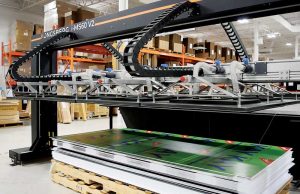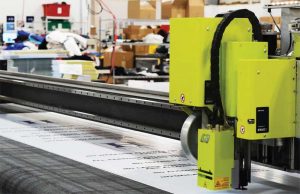
Wide-format printing is becoming more accessible and more affordable, thanks to new developments in processes as well as equipment. Photos courtesy SinaLite
By Brian Meshkati
Today’s technology allows sign shops and print companies to produce larger items, while still maintaining high-quality standards and efficiency. These developments contribute to the success of the wide-format printing market, which is forecast to reach a value of US$11.4 billion (C$15.4 billion) in 2026—up from US$8.8 billion (C$11 billion) in 2021.1 They also help these businesses offer more products to their customers, which, in turn, ensures steady revenue.
As with any other practice, wide-format printing has progressed as technology and consumer behaviour changes, giving rise to new trends. The category continues to evolve, so new trends are expected to arise in the coming months and years.
Here is a look at some of the current and emerging trends print service providers (PSPs) can expect to see in 2023 and beyond.
Developments in wide-format printing
Wide-format printing is becoming more accessible and more affordable, thanks to new developments in processes and equipment. Some of these developments include ultraviolet (UV)-curable inks, the ability to print on rigid media, and contour cutting technology.
UV-curable inks
UV-curable inks make it easier for PSPs to print on a wider range of substrates. This includes materials such as glass, plastics, and metals, which do not absorb other types of ink. Another benefit to using UV-curable inks is lower costs, which can be passed on to end customers. These inks also allow for faster completion times and are better for the environment compared to many other types of inks.
Printing on rigid media
Wide-format printers can now print directly onto a variety of hard surfaces, eliminating previously necessary, time-consuming steps. For example, the process used to include printing on a softer surface first, which would then be transferred to the harder surface. Eliminating these steps helps make printing on these types of media faster and more cost-effective.
Contour cutting
The latest contour cutting technology allows printers to cut a design to precise dimensions. With help from digital technology, designs can be cut easily, quickly, and accurately, to ensure the product is made to precise specifications. This technology also helps to make the process faster and helps reduce overall costs.

Today’s printing technology has allowed service providers to produce larger items, while still maintaining high-quality standards and efficiency.
Producing small print runs
In the past, one of the biggest problems with printing was the cost and time of setting up equipment—including templates for specific print jobs. This issue meant customers would have to make large orders for the job to be cost-effective. Of course, this was no good to companies that only received small orders, meaning many would have to look for alternatives.
In 2023, more companies will likely make small wide-format orders, including single-item runs. Technological developments have now made small runs economically viable for PSPs and their customers. Consumers can now make customized, bespoke orders for high-quality, wide-format products without breaking the bank. Small runs also make it more affordable to experiment, helping businesses and their clients find formulas to boost sales and revenue.
Another benefit of having small run capability is it lets print companies and sign shops offer a wider range of services to their clients. In some cases, offering small runs will even help a company attract customers away from their competition. Additionally, when a customer uses a company for one service, they are more likely to use its other services. A single, small-run order can sometimes develop into a long-term partnership, which is fruitful for both parties involved.





